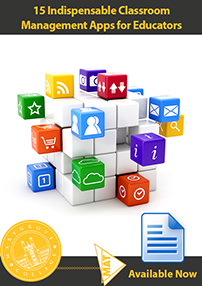 Dr. Richard Curwin is one scholar we continue to return to for advice on classroom management and student engagement. He’s been teaching and publishing books on discipline, motivation and classroom management for 40 years and his book, Discipline with Dignity, has long been a staple text in the education community.
Dr. Richard Curwin is one scholar we continue to return to for advice on classroom management and student engagement. He’s been teaching and publishing books on discipline, motivation and classroom management for 40 years and his book, Discipline with Dignity, has long been a staple text in the education community.
Since we find his work to be so helpful, we thought we’d share a five of his quick strategies to increase student motivation.
5 Quick Strategies to Increase Student Motivation
Be Persistent
If you need help remembering this strategy, just remember the tag line from your favorite Arnold Schwarzenegger flick: “I’ll be back.”
When we call on students who are uninvolved or not paying attention, many of them respond with, “I don’t know.” At first we smile and do our best to engage these students, but after a while, it’s tempting to give up and call on students who are more likely to respond.
Don’t allow these students to wear you down. Instead, channel the Terminator. Here’s how your dialogue might go:
You: Joe, how do you think that chemical weapons impacted the outcome of WWI?
Joe: I don’t know.
You: That’s OK. It’s a tough question, but you deserve another chance. I’ll come back to you.
After you call on a few other students, return to Joe.
You: Joe, what do you think of Ellen’s response to the question?
Joe: Don’t care.
You: No problem, but I still think you deserve a chance to share your thoughts. I’ll be back in a minute.
Continue doing this until Joe gives an answer.
What’s the strategy? You’re letting Joe know—in a very gentle way—that no one gets off the hook; everyone is expected to participate.
Reduce distractions
All of us are vulnerable to distractions, but students with ADHD are especially susceptible to them. Some students may benefit from “screening out” visual distractions by building a carrel desk out of two manila folders stapled together to form a three-sided structure.
In order to find an outlet for their energy, some students resort to tapping on their desks with pencils, which can be extremely distracting to others. You may be able to help these students by offering them an object from your fidget bucket. This may include stress balls, stuffed animals or even random items that you have lying around the house like bottle caps, corks and magnets. Objects like this allow students to keep their hands busy, but still focus on what’s going on in the classroom.
Another good way to accommodate students who struggle to sit through an entire class is to borrow or purchase adjustable music stands. These will give students the ability to sit or stand as necessary.
Start on Time
Many teachers don’t start class on time. Some are putting final touches on the lesson, writing on the board, or simply waiting around for the rest of the students to show up after the bell rings. As Curwin suggests, “Starting class late, however, can exacerbate tardiness: the later class starts, the later students know they can be.”
Start class on time and do not wait for tardy students. Those who show up on time shouldn’t have to wait for those that don’t. As an incentive to get your students to class on time, begin your lessons with something they won’t want to miss.
Protect Against Procedural Satiation
You classroom management strategies may work for a while, but eventually most procedures satiate or stop working entirely. Standing silently in front of the classroom and waiting may work at first, but after a while, no amount of waiting will send the message. Curwin suggests developing between five and ten “get quiet” procedures and switching when one stops working.
Follow Your Own Rules
Students are bombarded by rules—and by adults who live by the “do as I say, not as I do” adage. Be the example. If you want students to turn their work in when it is due, return their work when you say you will. When you tell students to dress appropriately, do so yourself.
As Curwin suggests, “When students see teachers breaking their own rules, it sends a message that the rule is unimportant and that it is OK for them to break the rules, too.
Replies to This Discussion
-
There are endless ways to help engage students in the classroom like use of various effective teaching strategies. Think creative and different. You can transform any dull textbook subject into an active learning experience that connect to a real-life situation. What about creating games around the subject ?
© 2025 Created by Steve Hargadon.
Powered by
![]()
